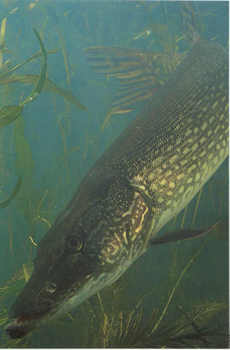 Pike head out for deep-water areas for various reasons.
Pike head out for deep-water areas for various reasons.
- Weather conditions
- water temperatures
- food availability
- fishing pressure.
All of these can all play roles separately or in combination as to why they leave the shallows. Successful anglers that troll, have ways of dredging up those deep-water fish, however, they run a variety of lures into the strike zone.
Crank Baits And Wire Line Trolling over, around and through schools of suspended baitfish is also effective when it comes to locating deep-water pike.
Once again, the angler should use a fish finder with depth to find schools of suspended forage fish, and to determine how deep to run the lures.
Deep-diving crank baits are excellent for working depths of 15 feet to 35 feet. If you use wire or lead-core line, you can work at even greater depths. There is no doubt that deep-diving lures work. The drawback to these giant deep-divers is that you need arms like an Olympic weightlifter if you plan on trolling for more than a few hours. A set of high-quality rod holders can be invaluable in this situation.
They make deep-water trolling more comfortable and fun, extending the hours you’re willing to devote to trolling. In most cases, the boat’s forward movement will even set the hooks. Of course the hooks must be honed to perfect sharpness so the barbs will penetrate the pike’s bony mouth. Wire line is the choice when the fish are holding deeper than the trolling lures will reach.
 Deep-water weed beds or the deep edges of shallow weed beds are perfect examples of this type of situation. Using a depth finder, you can maintain trolling position along the edge, and allow the wire to take the lure to the proper depth. Another advantage wire line has over monofilament is that it will slice through vegetation. If you’re line is caught in vegetation, you need only give a good jerk or two on the rod. You don’t have to reel it in. This saves time and energy. If wire-lining doesn’t suit you, a simple three-way swivel, rigged with a heavy sinker at the end of a 6-inch drop line, will sometimes suffice. The three-way rig works much like a downrigger, except that you’ll have to fight the sinker’s weight, as well as the fish. Normally, you’ll fish a three-way rig in the 20-foot or 30-foot depths. The 4 ounces to 8 ounces required to sink a small lure to the desired trolling depth is not enough to hinder an angler who is using heavy tackle.
Deep-water weed beds or the deep edges of shallow weed beds are perfect examples of this type of situation. Using a depth finder, you can maintain trolling position along the edge, and allow the wire to take the lure to the proper depth. Another advantage wire line has over monofilament is that it will slice through vegetation. If you’re line is caught in vegetation, you need only give a good jerk or two on the rod. You don’t have to reel it in. This saves time and energy. If wire-lining doesn’t suit you, a simple three-way swivel, rigged with a heavy sinker at the end of a 6-inch drop line, will sometimes suffice. The three-way rig works much like a downrigger, except that you’ll have to fight the sinker’s weight, as well as the fish. Normally, you’ll fish a three-way rig in the 20-foot or 30-foot depths. The 4 ounces to 8 ounces required to sink a small lure to the desired trolling depth is not enough to hinder an angler who is using heavy tackle.
 Late fall is prime time for using a three-way rig to take trophy northern. Weather transitions and falling water temperatures push pike into deeper water. The fish will be feeding, but you’ll have to reduce trolling speed and run the bait right over them. Baits such a: • Fat Raps • Rat-L-Traps • Rattlin’ Raps • No.13 Floating Rapalas -often work best. Colors vary
Late fall is prime time for using a three-way rig to take trophy northern. Weather transitions and falling water temperatures push pike into deeper water. The fish will be feeding, but you’ll have to reduce trolling speed and run the bait right over them. Baits such a: • Fat Raps • Rat-L-Traps • Rattlin’ Raps • No.13 Floating Rapalas -often work best. Colors vary such as chartreuse, fluorescent orange, bright yellow or combinations of these colors really turn on late-fall pike.
such as chartreuse, fluorescent orange, bright yellow or combinations of these colors really turn on late-fall pike.
Follow our HUNTING BLOG
WEB RATES FISH HUNT CABINS PHOTOS
TESTIMONIALS BROCHURE HUNT BOOKLET
